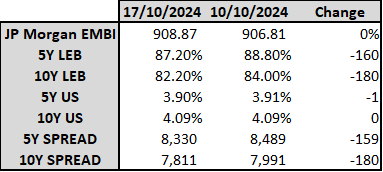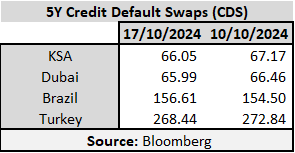

The BLOM Bond Index (BBI), which tracks Lebanese government Eurobonds (excluding coupon payments), continued his upward trend this week and rose 2.34% to 7.22 points, marking a new yearly peak. This rise is fueled by growing expectations that the weakening of Hamas and Hezbollah could lead to a ceasefire, which may stabilize Lebanon’s economy and help end the prolonged default on its bonds. Yesterday, Yahya Sinwar, the leader of Hamas, was killed by Israeli forces in Gaza, a significant blow to the group. The violence continues for Hezbollah as well, with Israeli strikes killing many of its leaders and fighters in recent weeks. As the series of killings escalates, there is an expectation that Sinwar’s death could create an opportunity for a ceasefire, which may help restore investor confidence and create a more stable financial outlook for Lebanon.
As bond prices rise, yields decrease. Consequently, the yields on 5-year and 10-year Lebanese Eurobonds fell this week by 160 and 180 basis points, respectively, reaching 87.2% and 82.2% by October 17, 2024.
In the U.S., the yield curve stayed stable this week, with one-year, five-year, and ten-year yields standing at 4.21%, 3.9%, and 4.09% on October 17, 2024.
This stability that keeps yield near their highest levels since July follows a 0.4% rise in retail sales for September, surpassing economists’ expectations of 0.3%, as per the Dow Jones polls. Additionally, weekly jobless claims fell by 19K to 241K, indicating a stronger economy. These positive economic indicators give the Federal Reserve more flexibility regarding interest rate cuts in its next meeting, and it could lead to smaller interest rate cuts in the future.
The yields’ high levels also reflect some polls suggesting that Donald Trump’s chance of winning the upcoming presidential election recently increased. If Trump wins, analysts expect his expansionary fiscal policies—such as tax cuts and fewer regulations—to drive inflation higher. This scenario could complicate the Fed’s ability to cut interest rates further, as rising inflation might force the Fed to slow its rates cutting cycle. While these policies could initially stimulate the economy, they may also lead to larger budget deficits and concerns about long-term debt sustainability. Consequently, investors may demand higher yields on bonds to compensate for these risks, leading to a sell-off in the bond market, thus lower bonds prices.
These developments have led some analysts to reconsider the likelihood of aggressive rate cuts. Traders are now pricing in an 92.1% chance of a quarter-point rate cut at the Federal Reserve’s November meeting, while the likelihood of no change is just 7.9%, according to the CME Group’s FedWatch tool.


Disclaimer:
This article is a research document that is owned and published by BLOMINVEST Bank SAL.
No material from this publication may be modified, copied, reproduced, repackaged, republished, circulated, transmitted or redistributed directly or indirectly, in whole or in any part, without the prior written authorization of BLOMINVEST Bank SAL.
The information and opinions contained in this document have been compiled from or arrived at in good faith from sources deemed reliable. Neither BLOMINVEST Bank SAL, nor any of its subsidiaries or affiliates or parent company will make any representation or warranty to the accuracy or completeness of the information contained herein.
Neither the information nor any opinion expressed in this research article constitutes an offer or a recommendation to buy or sell any assets or securities, or to provide investment advice.
This research article is prepared for general circulation and is circulated for general information only.